TOYOTA 4RUNNER 1998 Owners Manual
Manufacturer: TOYOTA, Model Year: 1998, Model line: 4RUNNER, Model: TOYOTA 4RUNNER 1998Pages: 350, PDF Size: 2.25 MB
Page 191 of 350
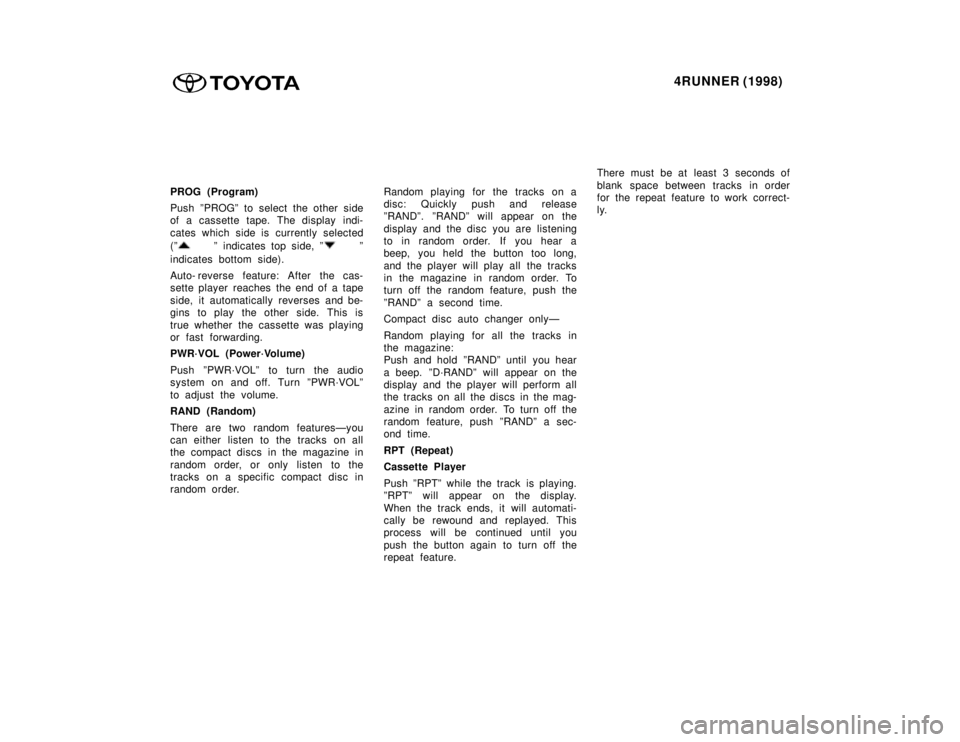
4RUNNER (1998)
PROG (Program)
Push ºPROGº to select the other side
of a cassette tape. The display indi-
cates which side is currently selected (º
º indicates top side, ºº
indicates bottom side).
Auto- reverse feature: After the cas-
sette player reaches the end of a tape
side, it automatically reverses and be-
gins to play the other side. This is
true whether the cassette was playing
or fast forwarding.
PWR´VOL (Power´Volume)
Push ºPWR´VOLº to turn the audio
system on and off. Turn ºPWR´VOLº
to adjust the volume.
RAND (Random)
There are two random featuresÐyou
can either listen to the tracks on all
the compact discs in the magazine in
random order, or only listen to the
tracks on a specific compact disc in
random order. Random playing for the tracks on a
disc: Quickly push and release
ºRANDº. ºRANDº will appear on the
display and the disc you are listening
to in random order. If you hear a
beep, you held the button too long,
and the player will play all the tracks
in the magazine in random order. To
turn off the random feature, push the
ºRANDº a second time.
Compact disc auto changer onlyÐ
Random playing for all the tracks in
the magazine:
Push and hold ºRANDº until you hear
a beep. ºD´RANDº will appear on the
display and the player will perform all
the tracks on all the discs in the mag-
azine in random order. To turn off the
random feature, push ºRANDº a sec-
ond time.
RPT (Repeat)
Cassette Player
Push ºRPTº while the track is playing.
ºRPTº will appear on the display.
When the track ends, it will automati-
cally be rewound and replayed. This
process will be continued until you
push the button again to turn off the
repeat feature.There must be at least 3 seconds of
blank space between tracks in order
for the repeat feature to work correct-
ly.
Page 192 of 350

4RUNNER (1998)
Compact Disc Player
There are two repeat featuresÐyou
can either replay a disc track or a
whole compact disc.
Repeating a track:
Quickly push and release ºRPTº while
the track is playing. ºRPTº will appear
on the display. If you hear a beep,
you held the button too long, and the
player will repeat the whole disc.
When the track ends, it will automati-
cally be replayed. This process will be
continued until you push the button
again to turn off the repeat feature.
Compact disc auto changer onlyÐ
Repeating a disc:
Push and hold ºRPTº until you hear a
beep. ºD´RPTº will appear on the dis-
play. The player will repeat all the
tracks on the disc you are listening
to. When the disc ends, the player
will automatically go back to the top
track of the disc and replay. This pro-
cess will be continued until you push
the button again to turn off the repeat
feature. SCAN
Radio
You can either scan all the frequen-
cies on a band or scan only the pre-
set stations for that band.
To scan all the frequencies:
Quickly push and release ºSCANº. If
you hear a beep, you held the button
too long, and the radio will scan the
preset stations. The radio will find the
next station up the station band, stay
there for a few seconds, and then
scan again. To select a station, push
ºSCANº a second time.
To scan the preset stations:
Push and hold ºSCANº until you hear
a beep. The radio will tune in the next
preset station up the band, stay there
for a few seconds, and then move to
the next preset station. To select a
station, push ºSCANº a second time.
Compact disc player
There are two scan featuresÐyou can
either scan the tracks on a specific
disc or scan the first tracks of all the
discs in the magazine.
Scanning for the tracks on a disc:
Quickly push and release ºSCANº.
ºSCANº will appear on the display and
the player will scan all the tracks on
the disc you are listening to. If you
hear a beep, you held the button too
long, and the player will scan the first
tracks of all the discs in the maga-
zine. To select a track, push the
ºSCANº a second time. If the player
scanned all the tracks on the disc, it
will stop scanning.
Compact disc auto changer onlyÐ
Scanning for the first tracks of all the
discs in the magazine:
Push ºSCANº until you hear a beep.
ºD´SCANº will appear on the display
and the player will perform the first
track of the next disc. To select a
disc, push the ºSCANº a second time.
If the player has scanned all the
discs, it will stop sc
anning.
Page 193 of 350

4RUNNER (1998)
SEEK (Seeking)
Radio
In the seek mode, the radio finds and
plays the next station up or down the
station band.
To seek a station, push and hold the º~ º or º !º side of ºSEEKº until you
hear a beep. Do this again to find
another station.
Cassette Player
By using this button, you can skip up
or down to a different track.
You can skip up to nine tracks at a
time.
Push the up or down side of the but-
ton. ºFF 1º or ºREW 1º will appear on
the display.
Next, push either side of the track
button until the number on the display
reaches the number of tracks you
want to skip. If you push the button
ten times, the skip feature will be
turned off. When counting the number of tracks
you want to rewind, remember to
count the current track as well. For
example, if you want to rewind to a
song that is two before the song you
are listening to, push on the down
side of the button until ºREW 3º ap-
pears on the display.
If you have pushed the track button
more than you wanted to, push the
other side of the button. The track
number will be reduced.
The track number you select is not
valid if it is higher than the number
of tracks remaining on the current
cassette side.
� After the beginning of the tape is
reached, the player will automati-
cally start playing the same side.
� After the end of the tape is
reached, the player will automati-
cally reverse sides and start play-
ing the other side.
There must be at least 3 seconds of
blank space between tracks for the
track button to work correctly. In addi-
tion, the feature may not work well
with some spoken word, live, or clas-
sical recordings. SKIP
The skip feature allows you to fast
forward past long stretches of blank
tape. This is especially useful at the
end of cassettes.
Push ºSKIPº. ºSKIPº will appear on
the display. The cassette player will
keep track of how much blank space
it plays. Any time it has played about
10 seconds of blank tape, it will auto-
matically fast forward to the next track
and begin to play.
Push the button a second time to turn
off the skip feature.
ST (Stereo reception) display
Your radio automatically changes to
stereo reception when a stereo broad-
cast is received. ºSTº appears on the
display. If the signal becomes weak,
the radio reduces the amount of chan-
nel separation to prevent the weak
signal from creating noise. If the sig-
nal becomes extremely weak, the ra-
dio switches from stereo to mono re-
ception.
Page 194 of 350
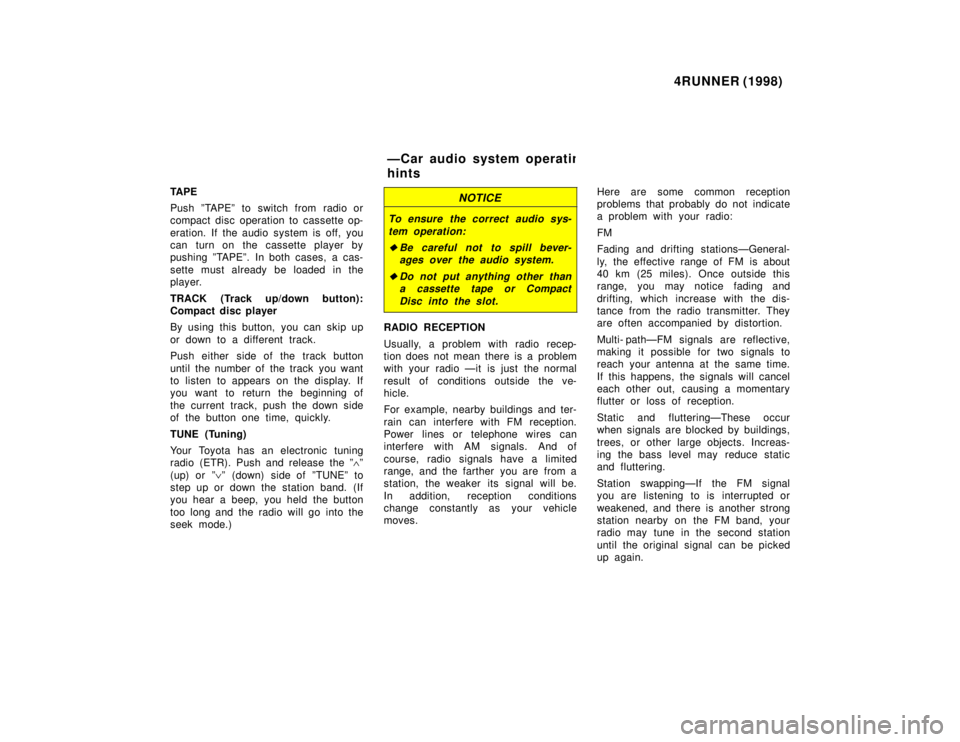
4RUNNER (1998)
TA P E
Push ºTAPEº to switch from radio or
compact disc operation to cassette op-
eration. If the audio system is off, you
can turn on the cassette player by
pushing ºTAPEº. In both cases, a cas-
sette must already be loaded in the
player.
TRACK (Track up/down button):
Compact disc player
By using this button, you can skip up
or down to a different track.
Push either side of the track button
until the number of the track you want
to listen to appears on the display. If
you want to return the beginning of
the current track, push the down side
of the button one time, quickly.
TUNE (Tuning)
Your Toyota has an electronic tuning
radio (ETR). Push and release the º ~º
(up) or º !º (down) side of ºTUNEº to
step up or down the station band. (If
you hear a beep, you held the button
too long and the radio will go into the
seek mode.)
NOTICE
To ensure the correct audio sys-
tem operation:
�Be careful not to spill bever-ages over the audio system.
�Do not put anything other thana cassette tape or Compact
Disc into the slot.
RADIO RECEPTION
Usually, a problem with radio recep-
tion does not mean there is a problem
with your radio Ðit is just the normal
result of conditions outside the ve-
hicle.
For example, nearby buildings and ter-
rain can interfere with FM reception.
Power lines or telephone wires can
interfere with AM signals. And of
course, radio signals have a limited
range, and the farther you are from a
station, the weaker its signal will be.
In addition, reception conditions
change constantly as your vehicle
moves. Here are some common reception
problems that probably do not indicate
a problem with your radio: FM
Fading and drifting stationsÐGeneral-
ly, the effective range of FM is about
40 km (25 miles). Once outside this
range, you may notice fading and
drifting, which increase with the dis-
tance from the radio transmitter. They
are often accompanied by distortion.
Multi- pathÐFM signals are reflective,
making it possible for two signals to
reach your antenna at the same time.
If this happens, the signals will cancel
each other out, causing a momentary
flutter or loss of reception.
Static and flutteringÐThese occur
when signals are blocked by buildings,
trees, or other large objects. Increas-
ing the bass level may reduce static
and fluttering.
Station swappingÐIf the FM signal
you are listening to is interrupted or
weakened, and there is another strong
station nearby on the FM band, your
radio may tune in the second station
until the original signal can be picked
up again.
ÐCar audio system operati
n
hints
Page 195 of 350

4RUNNER (1998)
AM
FadingÐAM broadcasts are reflected
by the upper atmosphereÐespecially
at night. These reflected signals can
interfere with those received directly
from the radio station, causing the ra-
dio station to sound alternately strong
and weak.
Station interferenceÐWhen a reflected
signal and a signal received directly
from a radio station are very nearly
the same frequency, they can interfere
with each other, making it difficult to
hear the broadcast.
StaticÐAM is easily affected by exter-
nal sources of electrical noise, such
as high tension power lines, lighten-
ing, or electrical motors. This results
in static.
CARING FOR YOUR CASSETTE
PLAYER AND TAPES
For high performance from your cas-
sette player and tapes:
Clean the tape head and other parts
regularly.
� A dirty tape head or tape path can
decrease sound quality and tangle
your cassette tapes. The easiest
way to clean them is by using a
cleaning tape. (A wet type is rec-
ommended.) Use high- quality cassettes.
� Low- quality cassette tapes can
cause many problems, including
poor sound, inconsistent playing
speed, and constant auto- revers-
ing. They can also get stuck or
tangled in the cassette player.
� Do not use a cassette if it has
been damaged or tangled or if its
label is peeling off.
� Do not leave a cassette in the
player if you are not listening to it,
especially if it is hot outside.
� Store cassettes in their cases and
out of direct sunlight.
� Avoid using cassettes with a total
playing time longer than 100 min-
utes (50 minutes per side). The
tape used in these cassettes is
thin and could get stuck or tangled
in the cassette player.
Page 196 of 350
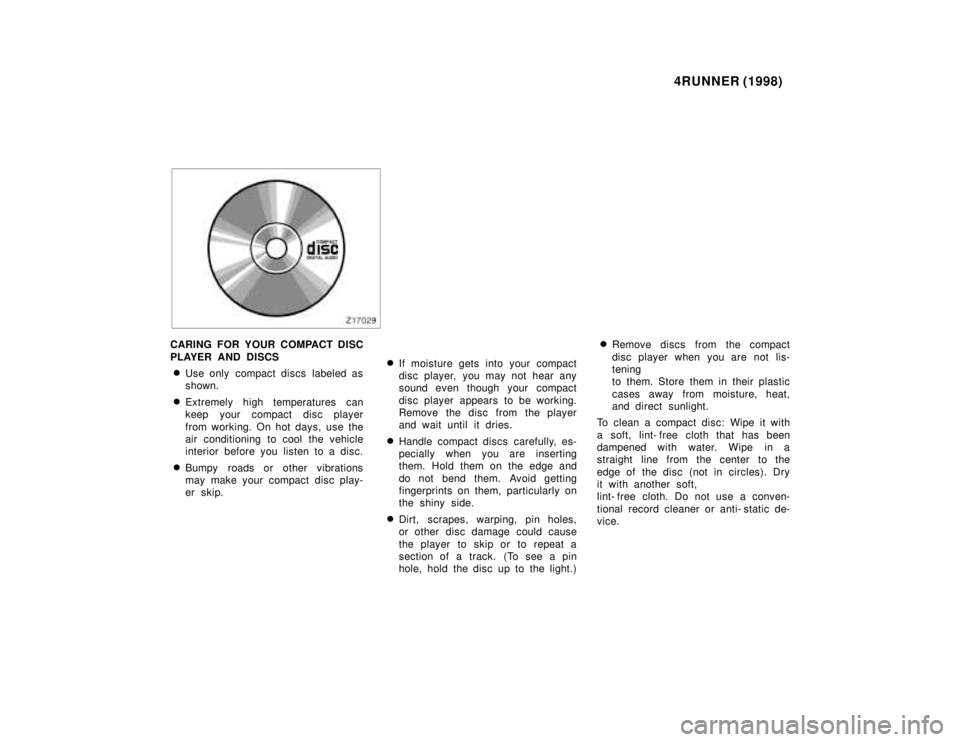
4RUNNER (1998)
CARING FOR YOUR COMPACT DISC
PLAYER AND DISCS
� Use only compact discs labeled as
shown.
� Extremely high temperatures can
keep your compact disc player
from working. On hot days, use the
air conditioning to cool the vehicle
interior before you listen to a disc.
� Bumpy roads or other vibrations
may make your compact disc play-
er skip. �
If moisture gets into your compact
disc player, you may not hear any
sound even though your compact
disc player appears to be working.
Remove the disc from the player
and wait until it dries.
� Handle compact discs carefully, es-
pecially when you are inserting
them. Hold them on the edge and
do not bend them. Avoid getting
fingerprints on them, particularly on
the shiny side.
� Dirt, scrapes, warping, pin holes,
or other disc damage could cause
the player to skip or to repeat a
section of a track. (To see a pin
hole, hold the disc up to the light.) �
Remove discs from the compact
disc player when you are not lis-
tening
to them. Store them in their plastic
cases away from moisture, heat,
and direct sunlight.
To clean a compact disc: Wipe it with
a soft, lint- free cloth that has been
dampened with water. Wipe in a
straight line from the center to the
edge of the disc (not in circles). Dry
it with another soft,
lint- free cloth. Do not use a conven-
tional record cleaner or anti- static de-
vice.
Page 197 of 350
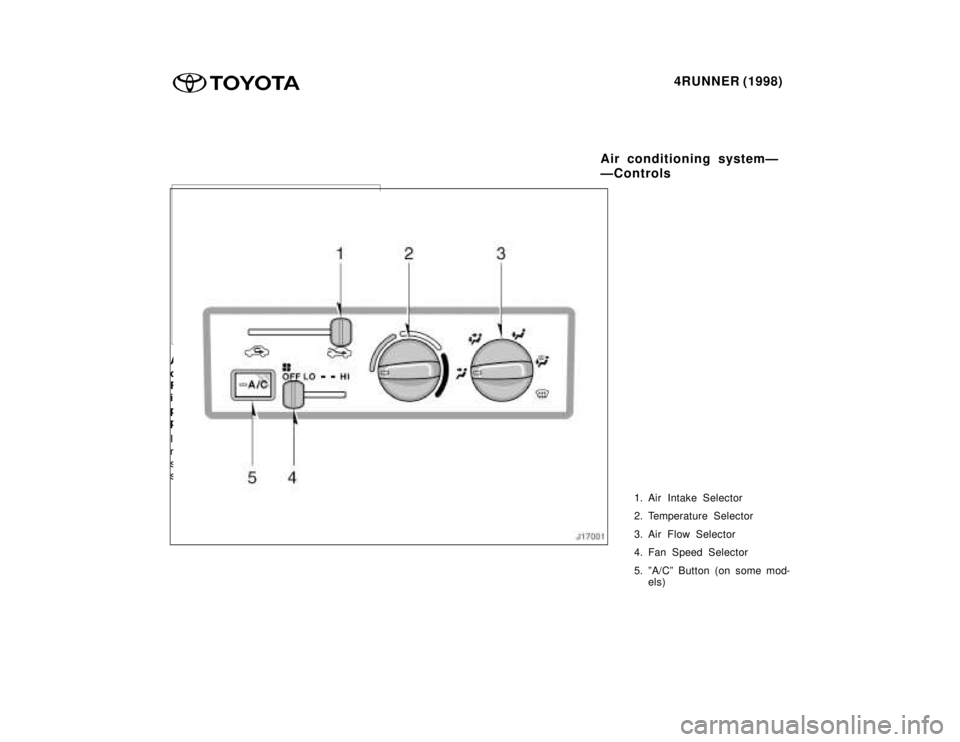
4RUNNER (1998)
A new disc may have rough edges
on its inner and outer perimeter.
Remove the rough edges by press-
ing the side of a ball- point pen or
pencil against the inner and outer
perimeter of the disc as shown.
If you continue to play a disc with
rough edges, flakes will fall on to the
signal side of the disc and cause
sound skipping or other problems.
CAUTION
Compact disc players use invis-
ible laser beam which could
cause hazardous radiation expo-
sure if directed outside the unit.
Be sure to operate the player cor-
rectly as instructed.
1. Air Intake Selector
2. Temperature Selector
3. Air Flow Selector
4. Fan Speed Selector
5. ºA/Cº Button (on some mod-
els)
Air conditioning systemÐ
ÐControls
Page 198 of 350
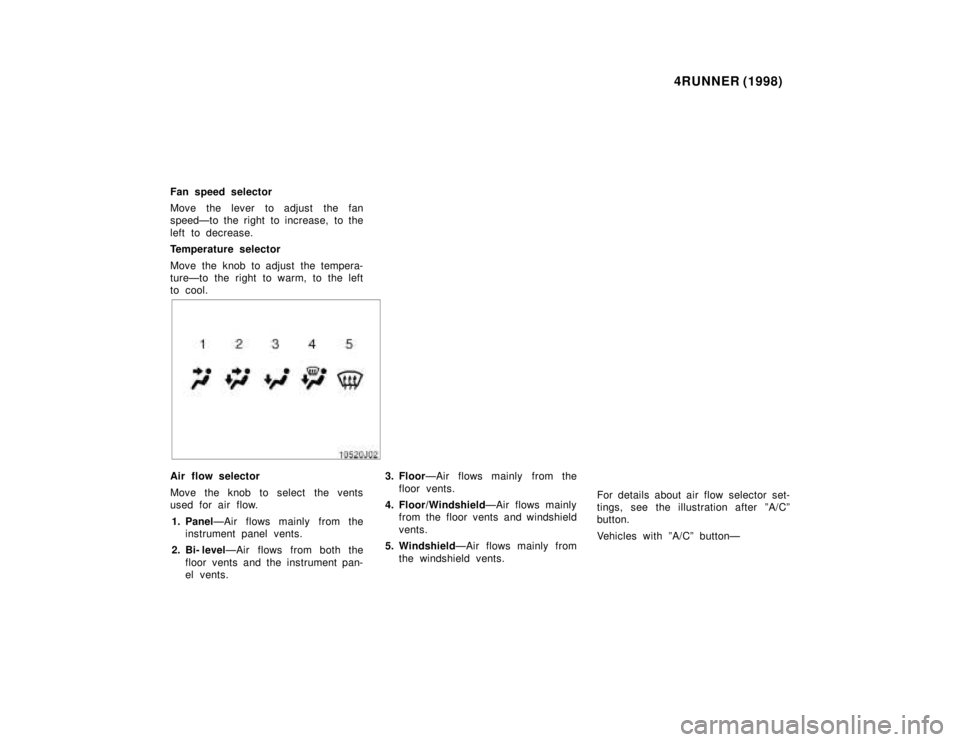
4RUNNER (1998)
Fan speed selector
Move the lever to adjust the fan
speedÐto the right to increase, to the
left to decrease.
Temperature selector
Move the knob to adjust the tempera-
tureÐto the right to warm, to the left
to cool.
Air flow selector
Move the knob to select the vents
used for air flow. 1. Panel ÐAir flows mainly from the
instrument panel vents.
2. Bi- level ÐAir flows from both the
floor vents and the instrument pan-
el vents. 3. Floor
ÐAir flows mainly from the
floor vents.
4. Floor/Windshield ÐAir flows mainly
from the floor vents and windshield
vents.
5. Windshield ÐAir flows mainly from
the windshield vents. For details about air flow selector set-
tings, see the illustration after ºA/Cº
button.
Vehicles with ºA/Cº buttonÐ
Page 199 of 350
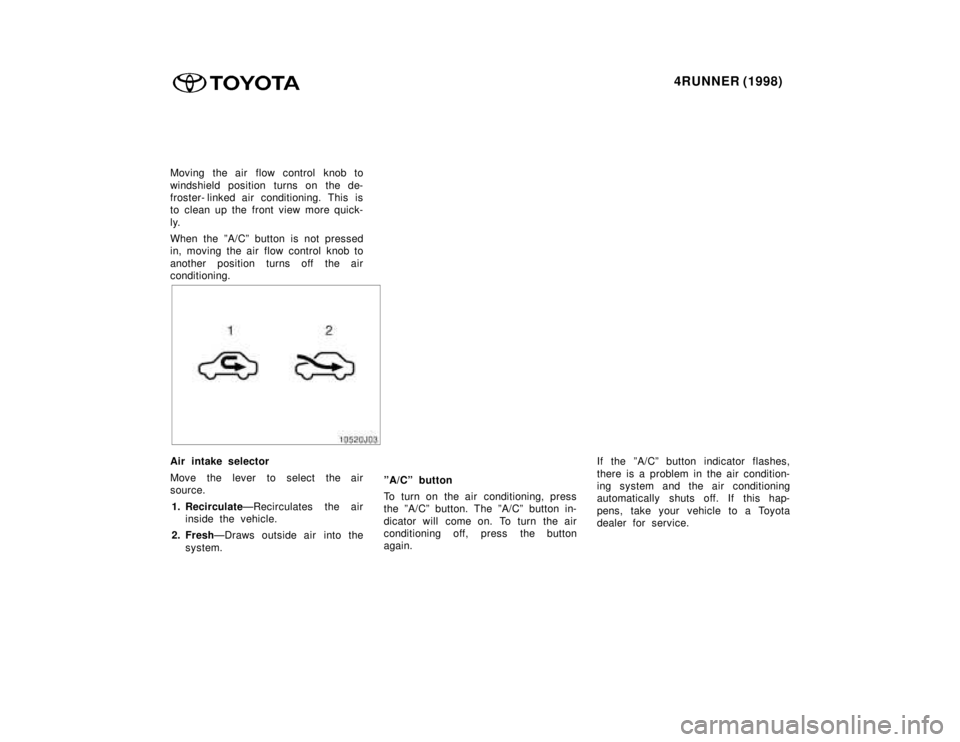
4RUNNER (1998)
Moving the air flow control knob to
windshield position turns on the de-
froster- linked air conditioning. This is
to clean up the front view more quick-
ly.
When the ºA/Cº button is not pressed
in, moving the air flow control knob to
another position turns off the air
conditioning.
Air intake selector
Move the lever to select the air
source.
1. Recirculate ÐRecirculates the air
inside the vehicle.
2. Fresh ÐDraws outside air into the
system. ºA/Cº button
To turn on the air conditioning, press
the ºA/Cº button. The ºA/Cº button in-
dicator will come on. To turn the air
conditioning off, press the button
again. If the ºA/Cº button indicator flashes,
there is a problem in the air condition-
ing system and the air conditioning
automatically shuts off. If this hap-
pens, take your vehicle to a Toyota
dealer for service.
Page 200 of 350
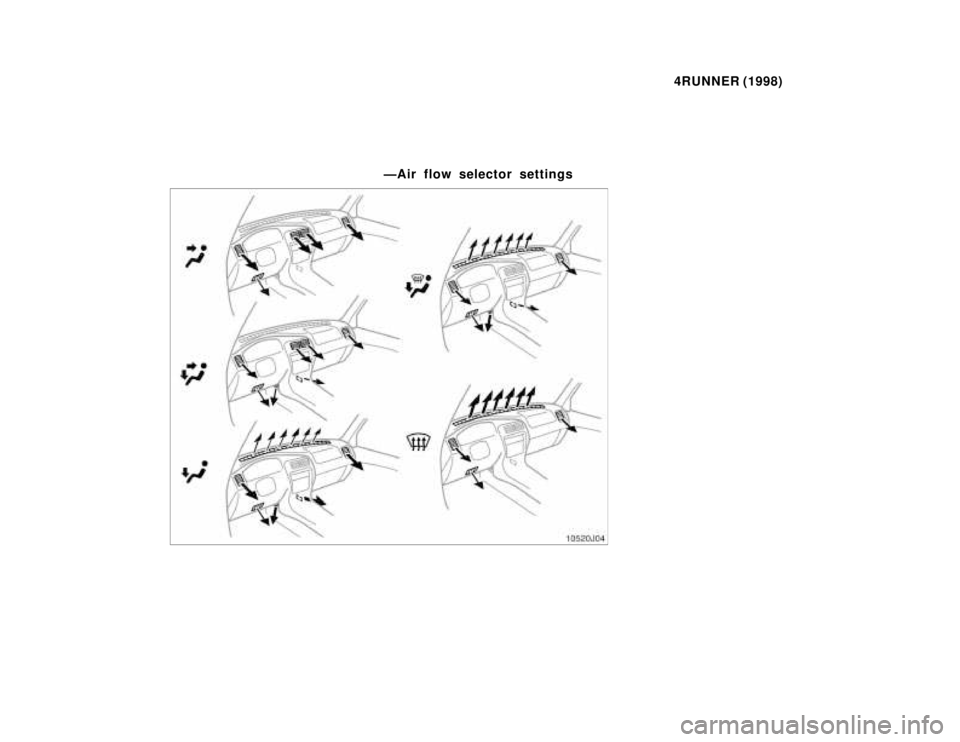
4RUNNER (1998)
ÐAir flow selector settings